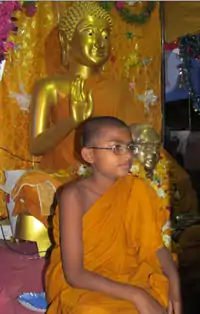Bhante
Bhante (Pali; Burmese: ဘန္တေ, pronounced [bàɰ̃tè]; Sanskrit: bhavantaḥ[1] is a respectful title used to address Buddhist monks and superiors in the Theravada tradition.
The term literally means "Venerable Sir."[2]

Etymology
Bhante is a gender-neutral term, and may be used to address both monks and nuns. It is the vocative form of the word bhadanta, which confers recognition of greatness and respect. In English, the term is often translated as Venerable.[3]
The Nepali terms bare and bande have the same derivation and are used to address Buddhist clergy.[4] Bhante can also be used as an honorific or a form of address to specific Buddhist monks, similar to Ajahn, Phra or Luang Por in Thailand or Ashin in Burma (Now Myanmar).
Some famous monks who are addressed with bhante include:
- Bhante K. Sri Dhammananda
- Bhante Dharmawara
- Bhante Henepola Gunaratana ("Bhante G.")
- Bhante Dhammalok Mahasthavir
- Bhante Kumar Kashyap Mahasthavir
- Bhante Pragyananda Mahasthavir
- Bhante Sitagu Sayadaw
- Bhante Vimalaramsi
Grammatically "bhante" is a vocative case form of a Pali word "bhadanta" (venerable, reverend). The vocative case denotes and is used for address.[5]
In literature
The title bhante is used among monks to address superiors within the sangha. The Pali Canon abounds with references to the Buddha's disciples addressing their seniors in this way. While the Buddha is usually addressed with the term Bhagavān, his disciples also sometimes addressed him as Bhante.
References
- "Bhante; 4 Definition(s)". Wisdom Library. Retrieved 2019-10-24.
- Rhys Davids, Thomas William; Steele, William, eds. (1905). The Pali-English dictionary (Reprint of Oxford 1905 edition, circa 1997 ed.). New Delhi / Chennai: Asian Educational Services. p. 498. ISBN 81-206-1273-6.
- Value Bhadanta, bhaddanta Pali Text Society Pali-English Dictionary
- The Circle of Bliss: Buddhist Meditational Art by John C. Huntington, Dina Bangdel. Serindia Publications: 2003 ISBN 1932476016 Page 29
- Buddhist Precept & Practice Gombrich, Richard F. Claredon Press: 1995 ISBN 0710304447, Page 141